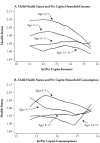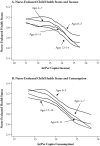Is the relationship between socioeconomic status and health stronger for older children in developing countries?
- PMID: 21305395
- PMCID: PMC2831276
- DOI: 10.1353/dem.0.0054
Is the relationship between socioeconomic status and health stronger for older children in developing countries?
Abstract
Recent research on the relationship between child health and income in developed countries reveals a positive gradient that is more pronounced for older children, suggesting that the impact of income upon health accumulates. This article examines whether the same is true in a developing country. Using data from the Indonesian Family Life Survey on children aged 0 to 14 years, we find that although low income adversely affects health, its impact does not differ by age. This finding is robust to the use of both subjective and objective health measures, controlling for selective mortality, the use of alternative measures of households' resources, and the inclusion of indicators of health at birth and parental health. One explanation for the constancy of the health-income relationship that we explore is the dominant role played by acute illness in determining the general health status of children in a developing-country context compared with the more central role played by chronic conditions in developed countries.
Figures





References
-
- Bago d’Uva T, Van Doorslaer E, Lindebloom M, O’Donnell O, Chatterji S.2006“Does Reporting Heterogeneity Bias the Measurement of Health Disparities?”University of York Health and Econometrics Data Group Working Paper 06/03. Department of Economics, University of York; Heslington, York, United Kingdom - PubMed
-
- Behrman JR, Foster AD, Rosenzweig MR, Vashishtha P. “Women’s Schooling, Home Teaching and Economic Growth”. Journal of Political Economy. 1999;107:682–714.
-
- Behrman JR, Rosenzweig MR. “Does Increasing Women’s Schooling Raise the Schooling of the Next Generation?”. American Economic Review. 2002;92:323–34.
-
- Cameron LA. “The Impact of the Indonesian Financial Crisis on Children: An Analysis Using the 100 Villages Data”. Bulletin of Indonesian Economic Studies. 2001;37(1):43–64.
-
- Case A.2001“Does Money Protect Health Status? Evidence From South African Pensions”Working Paper 268 Woodrow Wilson School of Public and International Affairs, Center for Health and Wellbeing, Princeton University; Princeton, NJ
Publication types
MeSH terms
LinkOut - more resources
Full Text Sources
